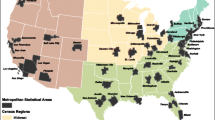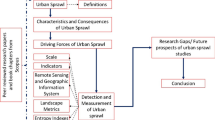Abstract
Transformation of land use in and around European cities is proceeding as fast as never before, and urban sprawl is a reality in Europe. This process is coming along with significant landscape changes that can even lead to the loss of landscape identity. Is it possible to find indications of which regions are prone to urban sprawl in order to curtail undesired future settlement developments in time? To answer this question we used settlement development scenarios for Switzerland, and analysed their spatial implications using a set of four metrics, which allow for comparing the degree of urban sprawl in different regions. Two aspects were explored: (1) by how much settlement development could potentially increase in Switzerland, and (2) the suitability of the metrics as indicators for characterizing and assessing the development of urban sprawl. The results show that overall in Switzerland the urban permeation and dispersion of settlement areas is likely to increase (in all scenarios), but to different degrees. However, the results differ very much between the various types of settlement and between the cantons, and even a decrease in urban dispersion is possible. In combination with scenarios of settlement growth, the metrics provide useful evidence on regional characteristics such as the overall pressure of settlement development and likely transformations of the respective settlement types that should be taken into account in spatial development concepts. There is a need for calibration of the indicators on a regional level to define specific thresholds to limit urban sprawl.









Similar content being viewed by others
References
Alterman, R. (1997). The challenge of farmland preservation. Lessons from a six-nation comparison. Journal of the American Planning Association, 63(2), 220–243.
Antrop, M. (2004). Landscape change and urbanization process in Europe. Landscape and Urban Planning, 67, 9–26.
Baccini, P., & Oswald, F. (Eds.) (1998). Netzstadt—Transdisziplinäre Methoden zum Umbau urbaner Systeme, Ergebnisse aus dem Forschungsprojekt SYNOIKOS der ETH Zürich. Zurich: vdf Hochschulverlag ETH Zurich.
Bengston, D. N., Fletcher, J. O., & Nelson, K. C. (2004). Public policies for managing urban growth and protecting open space: policy instruments and lessons learned in the United States. Landscape and Urban Planning, 69, 271–286.
Bishop, P., Hines, A., & Collins, T. (2007). The current state of scenario development: an overview of techniques. Foresight, 9(1), 5–25.
Catalán, B., Saurí, D., & Serra, P. (2008). Urban sprawl in the Mediterranean? Patterns of growth and change in the Barcelona Metropolitan Region 1993–2000. Landscape and Urban Planning, 85, 174–184.
Cede, P., & Steinicke, E. (2007). Ghost towns in den Ostalpen. Das Phänomen der Entvölkerung im friulanischen Berggebiet (Italien). Geographica Helvetica, 62(2), 93–103.
Ecoplan. (2005). Branchenszenarien Schweiz. Langfristszenarien zur Entwicklung der Wirtschaftsbranchen mit einem rekursiv-dynamischen Gleichgewichtsmodell (SWISSGEM). Bern: Bundesamt für Energie.
ESPON, European Spatial Planning Observation Network. (2006). ESPON project 3.2, Spatial scenarios and orientations in relation to the ESDP and cohesion policy. Final report Vol. 1 & 2, Executive summary and integrated scenarios. Denmark: ESPON.
Ewing, R. (1997). Is Los Angeles-style sprawl desirable? Journal of the American Planning Association, 63(1), 107–126.
Bundesamt für Statistik, B. F. S. (2006). Szenarien zur Bevölkerungsentwicklung der Schweiz 2005–2040. Neuchâtel: Swiss Statistics.
Fortin, M.-J., & Dale, M. R. T. (2005). Spatial analysis. A guide for Ecologists. Cambridge: Cambridge University Press.
Frenkel, A., & Ashkenazi, M. (2007). Measuring urban sprawl: how can we deal with it? Environment and Planning B, 35(1), 56–79.
Gagné, S. A., & Fahrig, L. (2007). Effect of landscape context on anuran communities in breeding ponds in the National Capital Region, Canada. Landscape Ecology, 22, 205–215.
Gennaio, M.-P., Hersperger, A. M., & Bürgi, M. (2009). Containing urban sprawl—Evaluating effectiveness of urban growth boundaries set by the Swiss Land Use Plan. Land Use Policy, 26, 224–232.
Grêt-Regamey, A. (2007). Predicting the scenic beauty value of mapped landscape changes in a mountainous region through the use of GIS. Environment and Planning B, 34, 50–67.
Grosjean, G. (1987). In E. Imhof (Ed.), Atlas der Schweiz. Wabern—Berne: swisstopo.
Hersperger, A. M., & Bürgi, M. (2009). Going beyond landscape change description: quantifying the importance of driving forces of landscape change in a Central Europe case study. Land Use Policy, 26, 640–648.
Higgs, G., Berry, R., Kidner, D., & Langford, M. (2008). Using IT approaches to promote public participation in renewable energy planning: prospects and challenges. Land Use Policy, 25, 596–607.
Jaeger, J., & Bertiller, R. (2006). Aufgaben und Grenzen von Messgrößen für die Landschaftsstruktur—das Beispiel Zersiedelung. In K. M. Tanner, M. Bürgi, & T. Coch (Eds.), Landschaftsqualitäten (pp. 159–184). Berne: Haupt.
Jaeger, J., Bertiller, R., Schwick, C., & Kienast, F. (2007a). Weiterhin steigende Zersiedelung der Schweiz: Wie lässt sich eine Trendwende erreichen? Geomatik Schweiz, 3, 114–117.
Jaeger, J., Bertiller, R., & Schwick, C. (2007b). Fortschreitende Zerschneidung und Zersiedelung der Landschaften in der Schweiz—unaufhaltsam? In Schweizerische Akademie der Geistes- und Sozialwissenschaften (Ed.), Wohnen in der Metropole Schweiz? (pp. 73–88). Bern: SAGW.
Jaeger, J., Schwick, C., Bertiller, R., & Kienast, F. (2008). Landschaftszersiedelung Schweiz—Quantitative Analyse 1935 bis 2002 und Folgerungen für die Raumplanung. Scientific final report. Swiss National Science Foundation, National Research Programme NRP 54 “Sustainable Development of the Built Environment”. Zurich, 344 pp.
Jaeger, J. A. G., Bertiller, R., Schwick, C., & Kienast, F. (2010a). Sutiability criteria for measures of urban sprawl. Ecological Indicators, 10, 387–406.
Jaeger, J. A. G., Bertiller, R., Schwick, C., Cavens, D., & Kienast, F. (2010b). Urban permeation of landscapes and sprawl per capita: New measures of urban sprawl. Ecological Indicators, 10, 427–441.
Kasanko, M., Barredo, J. I., Lavalle, C., McCormick, N., Demicheli, L., Sagris, V., et al. (2006). Are European cities becoming dispersed? A comparative analysis of 15 European urban areas. Landscape and Urban Planning, 77, 111–130.
Kim, K.-H., & Pauleit, S. (2007). Landscape character, biodiversity and land use planning: the case of Kwangju City Region, South Korea. Land Use Policy, 24, 264–274.
Nassauer, J. I., & Corry, R. C. (2004). Using normative scenarios in landscape ecology. Landscape Ecology, 19, 343–356.
Nohl, W. (2001). Sustainable landscape use and aesthetic perception—preliminary reflections on future landscape aesthetics. Landscape and Urban Planning, 54, 223–237.
Perlik, M., Wissen, U., Schuler, M., Hofschreuder, J., Jarne, A., Keiner, M., Cavens, D., & Schmid, W. A. (2008). Szenarien für die nachhaltige Siedlungs- und Infrastrukturentwicklung in der Schweiz (2005-2030). Scientific final report. Swiss National Science Foundation, National Research Programme NRP 54 “Sustainable Development of the Built Environment”, Zurich, 303 pp.
Pond, B., & Yeates, M. (1994). Rural/urban land conversion III: a technical note on leading indicators of urban land development. Urban Geography, 15(3), 207–222.
Ritsema van Eck, J., & Koomen, E. (2008). Characterising urban concentration and land-use diversity in simulations of future land use. Annals of Regional Science, 42, 123–140.
Schneider, A., & Woodcock, C. E. (2008). Compact dispersed, fragmented, extensive? A comparison of urban growth in twenty-five global cities using remote sensed datea, pattern metrics and census information. Urban Studies, 45(3), 220–243.
Schuler, M., Dessemontet, P., Jemelin, C., Jarne, A., Pasche, N., & Haug, W. (2007). Atlas des räumlichen Wandels der Schweiz. Neuchâtel: Bundesamt für Statistik (BFS), Zürich: Verlag Neue Zürcher Zeitung.
Schultz, B., & Dosch, F. (2005). Trends der Siedlungsflächenentwicklung und ihre Steuerung in der Schweiz und Deutschland. disP, 160, 5–15.
Siedentop, S. (2005). Urban Sprawl—verstehen, messen, steuern. Ansatzpunkte für ein empirisches Mess- und Evaluationskonzept der urbanen Siedlungsentwicklung. disP, 160, 23–35.
Steingrube, W. (1998). Quantitative Erfassung, Analyse und Darstellung des Ist-Zustandes. In Akademie für Raumforschung und Landesplanung (Ed.), Methoden und Instrumente räumlicher Planung (pp. 67–93). Hannover: ARL.
Stephenson, J. (2008). The cultural values model: an integrated approach to values in landscapes. Landscape and Urban Planning, 84, 127–139.
Torrens, P. M. (2005). A toolkit for measuring sprawl. Applied Spatial Analysis and Policy, 1, 5–36.
Tsai, Y.-H. (2005). Quantifying urban form: compactness versus ‘Sprawl’. Urban Studies, 43(1), 141–161.
Ulfarsson, G. F., & Carruthers, J. I. (2006). The cycle of fragmentation and sprawl: a conceptual framework and empirical model. Environment and Planning B, 33, 767–788.
Walz, A., Lardelli, C., Behrendt, H., Grêt-Regamey, A., Lundström, C., Kytzia, S., et al. (2007). Participatory scenario analysis for integrated regional modelling. Landscape and Urban Planning, 81, 114–131.
Wissen, U., Schroth, O., Lange, E., & Schmid, W. A. (2008). Approaches to integrating indicators into 3D landscape visualisations and their benefits for participative planning situations. Journal of Environmental Management, 89, 184–196.
Acknowledgements
We thank Michael Wenzlaff for his generous programming work. Further we thank the research team members René Bertiller, Manfred Perlik, Jolanda Hofschreuder, Marco Keiner and Prof. Willy A. Schmid for their significant contributions to developing the scenarios and their useful thoughts and comments on this article. We thank two reviewers for their careful comments on the manuscript. Special thanks go to the Spatial Planning Agencies of all 26 Swiss cantons for providing the permission to use the harmonised GIS-database of the designated building zones of Switzerland (Swiss Federal Office for Spatial Development ARE). This work is part of the two projects “Scenarios for sustainable development of the built environment in Switzerland 2005–2030” and “Degree of urban sprawl in Switzerland: Quantitative analysis 1940–2002 and implications for regional planning”, which were funded by the Swiss National Science Foundation’s National Research Programme (NRP 54) “Sustainable Development of the Built Environment" (http://www.nfp54.ch). We thank the Swiss National Science Foundation and the NRP 54’s steering committee, especially Dr. Stefan Husi, for making this collaboration possible.
Author information
Authors and Affiliations
Corresponding author
Rights and permissions
About this article
Cite this article
Wissen Hayek, U., Jaeger, J.A.G., Schwick, C. et al. Measuring and Assessing Urban Sprawl: What are the Remaining Options for Future Settlement Development in Switzerland for 2030?. Appl. Spatial Analysis 4, 249–279 (2011). https://doi.org/10.1007/s12061-010-9055-3
Received:
Accepted:
Published:
Issue Date:
DOI: https://doi.org/10.1007/s12061-010-9055-3




